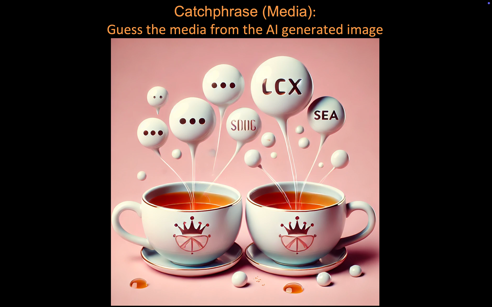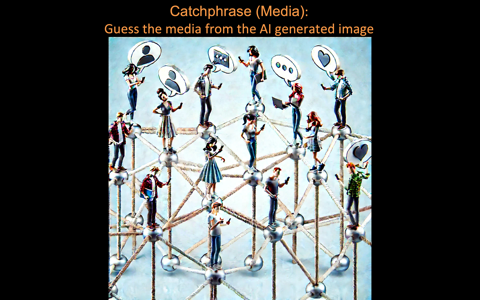Improving Visual Engagement Through Generative AI in Media Studies

Institution: Maynooth University
Discipline: Media Studies
Authors: Simon Hewitt
GenAI tool(s) used: ChatGPT
Situation / Context
This showcase focuses on the use of Generative AI (GenAI) supported visual engagement strategies in the BA Media Studies programme, the Media & Cultural Studies pathway of the BA Arts programme, and the MA in Critical and Creative Media programme at Maynooth University. Specifically, I use this approach in our large first-year undergraduate introductory Media Studies module (188 students), for which student participation in lectures can be particularly difficult to generate.
I also incorporate it in a postgraduate methods class for the MA and PhD students from the Department of Media Studies and the School of Modern Languages (15 students). Student participation can be easier to integrate here, but with such a variety of students, the need to provide unambiguous instructions to every student in every context becomes even greater. I have been teaching both modules since September 2023.
Task / Goal
In my experience, Media Studies students often have a natural inclination toward exploring new technologies like AI. But as per my modules policies, they are forbidden from using GenAI in their module assessments. Therefore, I want to offer concrete examples of ethical AI use to emphasise the benefits of this technology so they might explore it without undermining their capacity to develop their knowledge and critical thinking skills.
I also adopt Fiorella’s strategy of ‘generative learning’ into my teaching practice, which “involves [students] ‘making sense’ of provided learning material by actively organizing and integrating it with [their] existing knowledge” (2023: 1).
By creating visual engagement through visual puns for my in-class warm-up exercise (Catchphrase Media), I hoped to reflect the learner’s interests, which can be shown to increase generative learning motivation (Fiorella and Mayer, 2015: 719).
I also want to support students who struggle with purely text-based instructions to more easily traverse my Moodle page. Therefore, I use GenAI to create customised section images for my Moodle pages to help guide students to their desired information.
Actions / Implementation
Generating class participation from 188 first-year undergraduate students can be especially challenging. To motivate engagement, I create visual puns that the students must guess in a fun warm-up game that I include in my slides at the start of class. It is essentially an adaptation of the TV game show, Catchphrase. This approach is underpinned by the understanding that learning is a generative process in that it “occurs when learners build connections between the presented material and their prior knowledge (Mayer, 2010: 46).”
The following ChatGPT-generated images are based on examples of popular media, with which many of the students will be familiar, that also relate to that week’s topic of “Mediated Communication”. See figure below.



Answers = Gossip Girl Zoom The Social Network
Fig. 1: Examples of ChatGPT-generated images.
To reinforce ethical GenAI use, I include a slide at the beginning of every lecture before the warm-up game that reads “I created the following images on [date of creation] using ChatGPT and the prompt – create an image (a visual pun) based on the name of popular [insert form of media] that I will use in a trivia round”. I also refer back to these images when relevant, e.g., a later lecture discusses gender biases in media, for which I reuse the Gossip Girl image.
I also create section images for my Moodle pages using ChatGPT to help guide my students to their desired information. For example, figure below:

Fig. 2 Example of section images for my Moodle pages using ChatGPT.
This involves using the Grid course format on Moodle and then asking ChatGPT to create an abstract image based on the pre-planned title for each week’s classes, e.g., “Literature Review.” The image is abstracted because GenAI often returns text within the image, i.e., it will create an image that includes the text “Literature Review.”
Since each section is already labelled on Moodle, I did not want it to be labelled twice. The added benefit from a UDL perspective is that ChatGPT auto-includes alt-text that can be read by visually impaired students using screen readers, e.g., “A visual representation of a Literature Review.” Some adaptation may be required. For example, the “Please click on the tile below…” text was added via PowerPoint. I also include the note on the ethical use of GenAI within my Module Information section that says, “Note on icon creation: The icons on this Moodle page were created using GPT-4o using the prompt ‘create an abstract image that represents [title of icon needed]’.”
Outcomes
As part of the module feedback processes, I use a mid-session informal, anonymous suggestion box, as well as formal end of semester Moodle feedback surveys. The feedback has been overwhelmingly positive. The students express great affection for the Catchphrase warm-up game and can see its value:
- “The crowd involvement at the start of each lecture was quite enjoyable. It broke the silence of the start of a class and got people chatting.”
- “I liked how Simon is able to bring a sense of enthusiasm to the lectures; the [warm-up game] at the start of each lecture was always a great aspect.”
- “I really liked the [warm-up game] at the start.”
Additionally, I have received comments that my Moodle page is well-organised and easy to navigate. I also received positive comments from fellow staff who have since adopted the same presentation for their Moodle pages.
Overall, these steps have enabled me to reflect the learner’s interests by providing fun examples of media that help start that week’s discussion while also helping to guide students to their desired information on Moodle. However, more time will be needed to measure the impact of providing concrete examples of ethical AI use. I will, therefore, include a question about this in my upcoming end-of-semester Moodle feedback surveys.
Reflections
The most impactful feedback I received was about the warm-up game. Many students complained that I was initially too focused on filmic media. Instead, they wanted more examples that reflected their interests, e.g., video games, music, podcasting, and media specific to Ireland. My background as a filmmaker apparently influenced my incorrect assumption that anyone studying media would be interested in cinema to the same extent as I am. I have since adapted my strategy to include a wider variety of examples. I was also surprised that at least one student was hostile to GenAI use – “Do not use AI. It should not be used at all on campus.”
My hope is to instil a sense of ethical GenAI use because, as students progress through Media Studies, AI is a transformative technology that they will need to understand.
Further Reading
Mayer, R. E. (2010). Merlin C. Wittrock’s enduring contributions to the science of learning. Educational Psychologist, 45 (1), 46–50.
Fiorella, L. and Mayer, R. E. (2015). Eight Ways to Promote Generative Learning, Educational Psychology Review 28 pp. 717–741.
Fiorella, L. (2023). Making sense of generative learning. Educational Psychology Review, 35, 50.
Author Biography
Dr Simon Hewitt is an Assistant Professor in the Department of Media Studies at Maynooth University. His research focuses on the interstices between media audiences and media industries and the means by which this gap is bridged. His recent works include a chapter for an edited collection from Edinburgh University Press that discusses intermediality in UK scare attractions and an article for Convergence on video game and cinematic convergence in the late 1990s.

